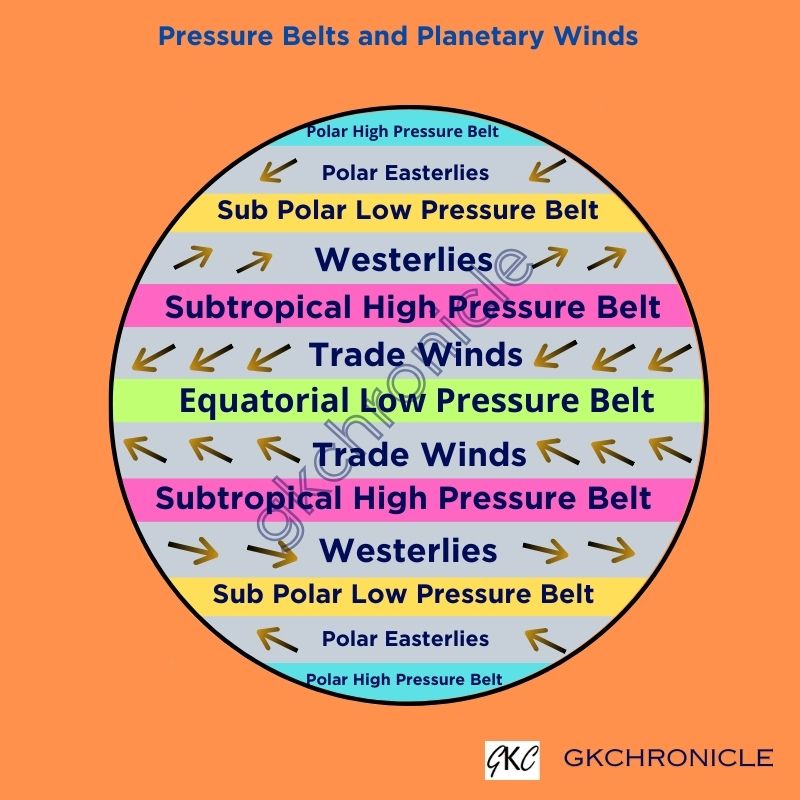World Geography / Climatology
Pressure Belts and Planetary Winds
Pressure varies from one place to the other place and also decreases with altitude resulting in world pressure belts and planetary winds.
Atmospheric pressure is nothing but the force exerted by the atmospheric column on a unit area of earth's surface. It is measured in the units of kg/cm2 or bars
or millibars or length of Mercury (Hg) column in cm or mm. At Mean Sea Level, the pressure is 76 cm of Hg column or 1013 millibars.
Pressure Belts of the World
- There exists 7 alternating high and low pressure belts of Earth. In the 7 pressure belts, there exists 4 types of
pressure belts namely,
(i) 1 Equatorial Low Pressure Belt (ELP)( 100 North - 50 South )
(ii) 2 Sub-Tropical High Pressure Belts (STHP)( 300 - 350 North and South )
(iii) 2 Sub Polar Low Pressure Belts (SPLP)( 600 - 66 1/20 North and South )
(iv) 2 Polar High Pressure Belts (PHP)( around 900 North and South )

- Of the 7 world pressure belts, Equatorial Low Pressure belt and Polar High Pressure belts of the Earth are formed due to thermal factors.
High temperature in equatorial region leads to low pressure in ELP belt and low temperature in polar regions leads to high pressure in PHP belts of the world.
Subtropical High Pressure belt is formed due to massive subsidence of winds which results in high pressure. Sub Polar Low Pressure belt,
also called Circum-Polar Low Pressure belt, is formed due to massive ascent of wind, resulting in low pressure.
- These pressure belts of the world are called Global pressure belts. Since pressure gradient is there from one belt to the other, wind blows from high pressure
region to low pressure region. But these winds are deflected by the Coriolis force (Centrifugal forces) arising due to earth's rotation.
- According to Ferrel's Law, in the northern hemisphere, the Coriolis force deflects the winds towards the right and in the southern hemisphere, they
are deflected towards the left. The deflection is minimum near the Equator and maximum at the Poles.
- From Sub-Tropical High Pressure belt to Equatorial Low Pressure belt, the winds are deflected moderately and are called Trade Winds or Tropical Easterlies. From Subtropical
High Pressure belt to Sub Polar Low Pressure belt, the deflection is high and appears as if blowing from west to east and hence are called Westerlies.
From
Polar High Pressure belt to Sub Polar Low Pressure belt, the deflection is high and appears as if blowing from east to west and hence are called Polar Easterlies.
- All these winds formed by the pressure belts are called Global winds or Planetary winds or Primary Winds. Out of the three types of winds that exist in the world,
these winds are of first kind.
Main Features of Planetary Winds
- These 3 types of Planetary winds are permanent winds. They flow throughout the year and also flow throughout the globe. They are responsible for the weather in a given region.
- Equatorial Low Pressure Belt is zone of wind convergence (having strong convective activity). Trade winds generally do not reach the
Equator ( up to 100N - 50 S ).
- Heated winds in ELP (convective winds) ascend vertically and even Trade Winds start ascending. Within the Equatorial region, there are no horizontal winds.
Equatorial Low Pressure belt is called Doldrums Zone. It is also known to be Intertropical Convergence Zone (ITCZ) as winds from Tropics converge here.
- Sub-Tropical High Pressure Belt is a zone of wind divergence. Here no strong (feeble) horizontal winds are present and hence called "Zone of Calm".
- The Latitudes in 300 - 350 north and south of the Equator are called Horse Latitudes because, as there are no horizontal winds here, the boats carrying horses through
these latitudes, used to come to halt and hence the horses were thrown into the seas in order to reduce the weight of boats.
- Towards the south of 350 S, there are very strong Westerlies, which are strong in the Southern hemisphere than in Northern hemisphere and boats
used to overturn here.
- 400 South Latitudes are called Roaring Forties. 500 South Latitudes are called Furious Fifties. 600 South
Latitudes are called Screaming Sixties or Shrieking Sixties.
- The winds formed due to world pressure belts and planetary winds are very strong in nature and are consistent in their direction.
Quiz
- Which latitudes are known as Horse latitudes?
- 300 - 350 North and South latitudes
- 400 - 450 North and South latitudes
- 500 - 550 North and South latitudes
- 600 - 650 North and South latitudes
Answer
Ans: A
- How many pressure belts are there in the world?
- 4
- 5
- 6
- 7
Answer
Ans: D
- Trade winds are also known as:
- Polar Easterlies
- Westerlies
- Tropical Easterlies
- Periodic winds
Answer
Ans: C



